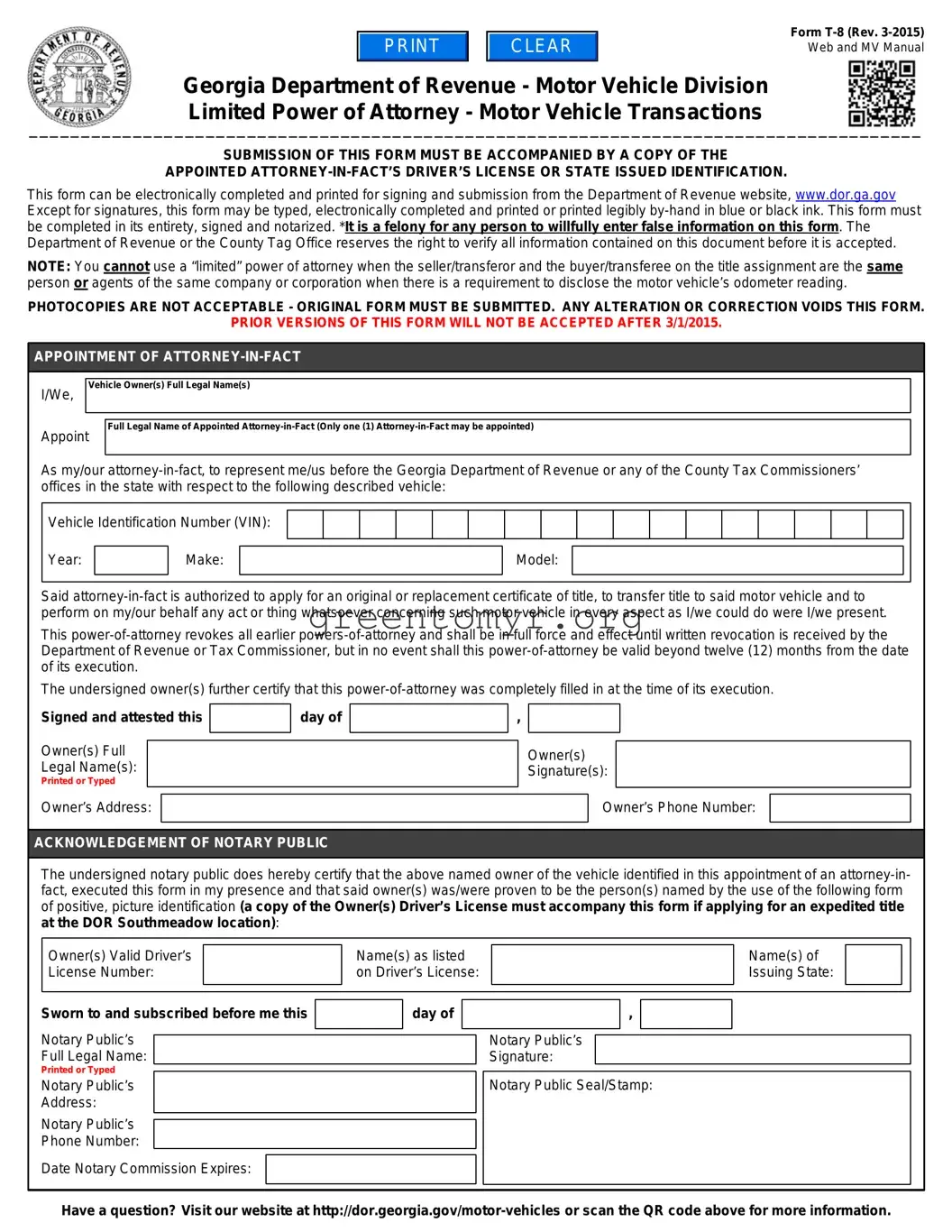Form T-8 (Rev. 3-2015)
Web and MV Manual
Georgia Department of Revenue - Motor Vehicle Division
Limited Power of Attorney - Motor Vehicle Transactions
______________________________________________________________________________________
SUBMISSION OF THIS FORM MUST BE ACCOMPANIED BY A COPY OF THE
APPOINTED ATTORNEY-IN-FACT’S DRIVER’S LICENSE OR STATE ISSUED IDENTIFICATION.
This form can be electronically completed and printed for signing and submission from the Department of Revenue website, www.dor.ga.gov Except for signatures, this form may be typed, electronically completed and printed or printed legibly by-hand in blue or black ink. This form must be completed in its entirety, signed and notarized. *It is a felony for any person to willfully enter false information on this form. The Department of Revenue or the County Tag Office reserves the right to verify all information contained on this document before it is accepted.
NOTE: You cannot use a “limited” power of attorney when the seller/transferor and the buyer/transferee on the title assignment are the same person or agents of the same company or corporation when there is a requirement to disclose the motor vehicle’s odometer reading.
PHOTOCOPIES ARE NOT ACCEPTABLE - ORIGINAL FORM MUST BE SUBMITTED. ANY ALTERATION OR CORRECTION VOIDS THIS FORM.
PRIOR VERSIONS OF THIS FORM WILL NOT BE ACCEPTED AFTER 3/1/2015.
APPOINTMENT OF ATTORNEY-IN-FACT
Vehicle Owner(s) Full Legal Name(s)
Full Legal Name of Appointed Attorney-in-Fact (Only one (1) Attorney-in-Fact may be appointed)
As my/our attorney-in-fact, to represent me/us before the Georgia Department of Revenue or any of the County Tax Commissioners’ offices in the state with respect to the following described vehicle:
Vehicle Identification Number (VIN):
Said attorney-in-fact is authorized to apply for an original or replacement certificate of title, to transfer title to said motor vehicle and to perform on my/our behalf any act or thing whatsoever concerning such motor vehicle in every aspect as I/we could do were I/we present.
This power-of-attorney revokes all earlier powers-of-attorney and shall be in full force and effect until written revocation is received by the Department of Revenue or Tax Commissioner, but in no event shall this power-of-attorney be valid beyond twelve (12) months from the date of its execution.
The undersigned owner(s) further certify that this power-of-attorney was completely filled in at the time of its execution.
Signed and attested this |
|
day of |
|
|
|
Owner(s) Full
Legal Name(s):
Printed or Typed
Owner’s Address:
,
Owner(s)
Signature(s):
Owner’s Phone Number:
ACKNOWLEDGEMENT OF NOTARY PUBLIC
The undersigned notary public does hereby certify that the above named owner of the vehicle identified in this appointment of an attorney-in- fact, executed this form in my presence and that said owner(s) was/were proven to be the person(s) named by the use of the following form of positive, picture identification (a copy of the Owner(s) Driver’s License must accompany this form if applying for an expedited title at the DOR Southmeadow location):
Owner(s) Valid Driver’s License Number:
Name(s) as listed on Driver’s License:
Name(s) of Issuing State:
Sworn to and subscribed before me this
Notary Public’s
Full Legal Name:
Printed or Typed
Notary Public’s
Address:
Notary Public’s
Phone Number:
Date Notary Commission Expires:
Notary Public’s
Signature:
Notary Public Seal/Stamp:
Have a question? Visit our website at http://dor.georgia.gov/motor-vehicles or scan the QR code above for more information.

